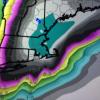https://easternmassweather.blogspot.com/2020/12/will-real-nao-please-stand-up.html
Will the Real NAO Please Stand Up
January 2021 Positions to Deliver the Blow That Latter December 2020 Did Not
Generalizations: The Cardinal Sin of Sociology and Meteorology
One of the most fundamental traits inherent of all human beings is that we love to be appreciated for all of our unique and innate abilities. Indeed, to generalize any individual as part of an indistinguishable larger group is to gloss over the qualities and abilities that define us as human beings, and provide us with our own sense of identity. Suffice to say, generalizations make it exceedingly difficult if not impossible to adequately characterize any human being, or anything else for that matter. We must treat the atmosphere the same way. Generalizations breed contempt, indifference, laziness and complacency. A generalization is an antonym of exhaustive, which is a term that should describe any forecaster worth reading. This is because in forecasting it is the aforementioned, minute idiosyncrasies that often differentiate between a mundane rainstorm and a paralyzing blizzard. Thus a forecasting approach fraught with generalizations can blind any prospective forecaster to the atmospheric nuances that are responsible for such tremendous variation in resultant sensible weather. This is the essence of why these generalizations are so inimical to making friends. Not only are those around you insulted, but they are ill prepared for the weather due to a shitty and tremendously flawed forecast that did not accurately and exhaustively assess all of the data at hand. This is a principle that Eastern Mass Weather warned against prior to the severe la nina winter of 2017-2018, as well as prior to the current season. The consensus was very mild in both instances due to a generalization of the respective la nina events, which is silly because one was east based and one mixed type. Central-based events are usually most mild and benign across the eastern US. Many of us are guilty of committing the same cardinal sin with respect to the characterization of teleconnections, and namely the NAO.
Much like ENSO Events, Location Crucial for Blocks
The month of December was not quite as active in terms of winter weather across the area as implied, in large part because the large Christmas event this past week was entirely rainfall across the region. The easy first guess would be because the NAO was not predominately negative, as expected, but this is not true.
A more exhaustive review of the data reveals why.
Latter December has been characterized by a "thumb ridge" of higher heights across the north atlantic to the south of Greenland, as opposed to a true block over Greenland.
Although technically registering as a negative NAO due to higher heights in the southern periphery of the NAO domain, this is not a block because it does nothing to "block" a storm from cutting inland. This was evidenced by the inland track of the Christmas low, and this same regime looks to plague the next event.
New Year's Storm Potential
Note that as a deep trough carves out in the center of the county later this week, we have yet to establish the block over Greenland.
While the initial instinct if to forecast a repeat of the Christmas storm, remember that it is important to consider each and every subtle nuance to the pattern.
Note that a subtle RNA signature briefly emerges:
Which is evidenced by the lower heights in the Pacific North West:
The lower heights in the PNW act to mute the amplification of the downstream trough due to the development of higher heights in the SE US.
This creates a delicate balance between how much the SW can retain its integrity, which will promote a more inland track, and how much it is attenuated by the fast flow of a compressed geopotential medium due to the fleeting SE ridge. The latter promotes a more seaward track and albeit a weaker system, a possible colder solution.
Whatever happens later this week, the plot then thickens by the second week of January.
Major Potential Looms Toward Mid January Due to Stratospheric Evolution
Currently, the stratosphere remains fairly weak, which creates the opportunity for cold to escape into the mid latitudes. However, that does not necessarily mean that it will escape into north America. In fact, currently the vast majority of the cold is focused in Asia.
Remember not to generalize all weakening PV episodes.
However there is now growing confidence that the balance of cold will begin to shift toward North America as we enter the new year.
This sets the stage for what currently looks to be a classic pattern for a major east coast snow storm during the second week of January.
While a true Sudden Stratospheric Warming is unlikely for reasons specified in the winter outlook, there does exist strong multi cluster support among ensemble guidance for such a a pattern to materialize.
GFS Ensemble agree with the aforementioned ECMWF mean:
Canadien Ensemble also concurs:
Should this fail to materialize, then there will not be a major east coast winter storm. While it may be overstated to a degree, which is often the case with respect to extended ensemble projections, there was some support for west-based NAO blocking during the first half of January in the analog composite.
Said blocking should begin to abate in latter January, potentially setting the stage for a significant late winter reprieve.




